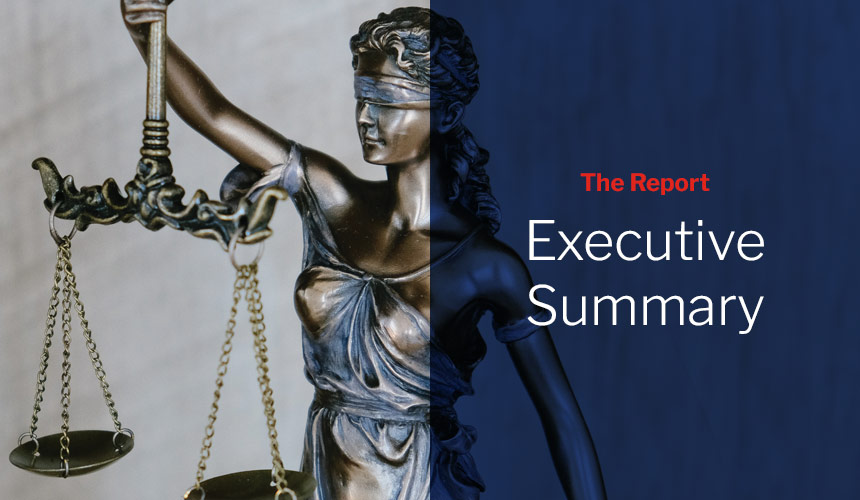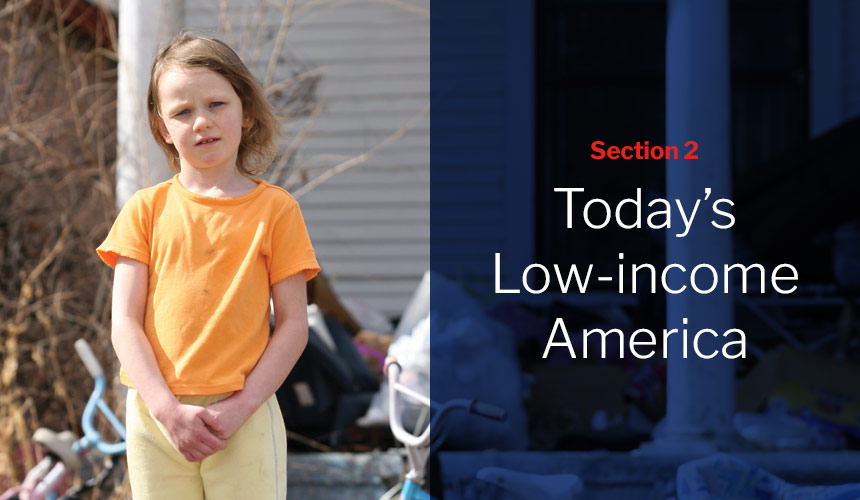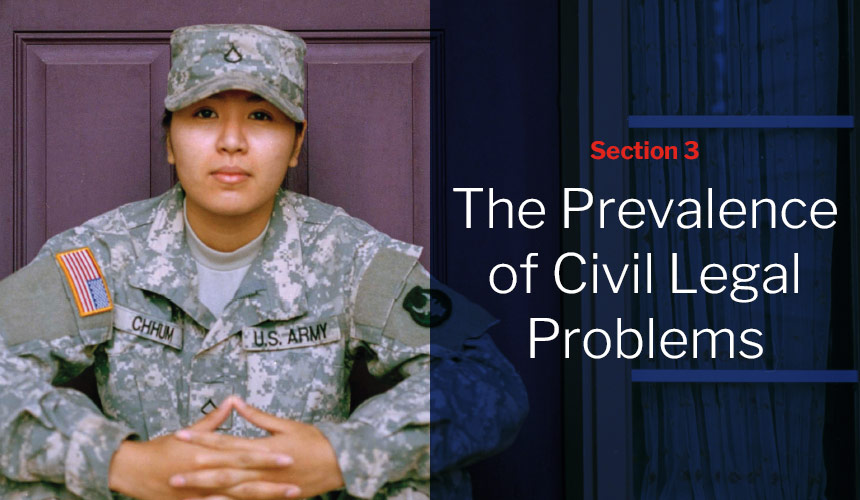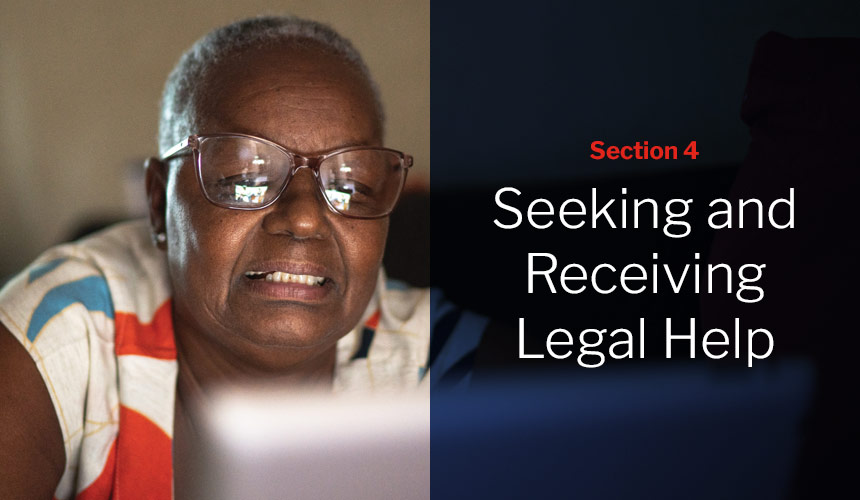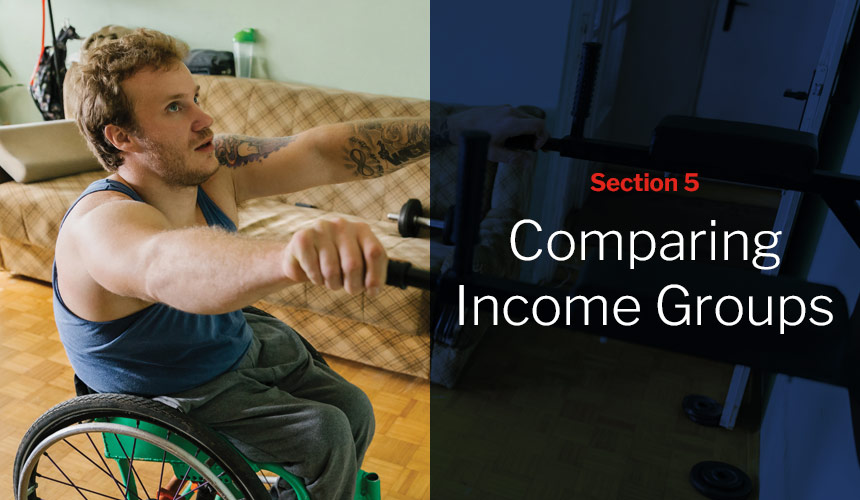The phrase “with liberty and justice for all” in the Pledge of Allegiance represents a fundamental ideal of this country. Yet, the reality of America’s justice system does not live up to this ideal. The United States is facing an access-to-justice crisis that disproportionately impacts our society’s most vulnerable. Despite our pledge of “with liberty and justice for all,” it is still the case that one’s access to justice in our nation too often depends on how much money one has.
In criminal cases, legal assistance is a right. Americans accused of a crime are given legal counsel if they cannot afford it. In contrast, one generally has no right to counsel in civil matters where people risk losing their homes, livelihoods, health, and families.1 Indeed, most low-income Americans must “go it alone” when grappling with civil legal matters – without access to legal information, advice, or representation to help them resolve the matter in our legal system. The result is an expansive “justice gap” – defined by the Legal Services Corporation (LSC) as the difference between the civil legal needs of low-income Americans and the resources available to meet those needs.
The justice gap is the difference between the civil legal needs of low-income Americans and the resources available to meet those needs.
This report shares findings from LSC’s 2022 Justice Gap Study. The 2022 study provides a fresh assessment of low-income Americans’ civil legal needs and the extent to which their legal needs are met. Its timing is particularly important because it allows us to consider the justice gap in the context of the COVID-19 pandemic, which has had disproportionate effects on this population. Additionally, this study sheds light on how low-income Americans’ experiences seeking legal help compare with the experiences of Americans with higher incomes.
Background
Legal Services Corporation
Established by Congress in 1974, LSC is the single largest funder of civil legal aid for low-income Americans in the nation. Its mission is to promote equal access to justice in the United States and provide high-quality civil legal assistance to low-income individuals. LSC distributes more than 90 percent of its total funding to 132 independent nonprofit legal aid organizations with more than 800 offices across the United States and its territories. These organizations provide legal assistance to low-income individuals grappling with civil legal problems related to basic needs, such as housing, health, employment, family, and safety
LSC’s Justice Gap Research
The 2022 Justice Gap Study is LSC’s fourth study since 2005. LSC’s first two studies (from 2005 and 2009) showed how limited resources make it impossible for LSC-funded legal aid organizations to meet all of the legal needs low-income individuals bring to them. LSC’s 2017 study explored the justice gap through a similar lens but did not stop there. That study also included a nationally representative survey of low-income American households to better understand people’s experiences dealing with civil legal problems more generally – regardless of whether they seek legal help. LSC largely modeled the 2022 study after the 2017 study, but also expanded the design to include higher-income groups and additional topics.
Study Methodology
The 2022 study leverages two primary data sources: the 2021 Justice Gap Measurement Survey and LSC’s 2021 Intake Census. We provide an overview of the methodologies used to produce the data below. Readers can find additional details about the study’s methodology on the study website.
2021 Justice Gap Measurement Survey
LSC contracted with NORC at the University of Chicago (NORC) to conduct a survey of more than 5,000 U.S. adults using its nationally representative, probability-based AmeriSpeak® Panel. The survey included a sample of n=2,003 adults from households at or below 125% of the federal poverty level (FPL) and a sample of n=3,305 adults from households above 125% of FPL. To maximize representation, NORC administered the survey using multiple modes (telephone and web) and in two languages (English and Spanish). NORC fielded the survey for seven weeks from October 15 to December 4, 2021.
LSC’s central objectives for the 2021 survey were twofold:
- Measure the prevalence of civil legal problems among low-income Americans, and
- Assess the extent to which low-income Americans receive the legal help necessary to resolve their civil legal problems.
Additionally, LSC designed the 2021 survey to also explore the impact of the COVID-19 pandemic on civil legal needs; identify potential barriers to seeking and receiving legal help; and evaluate differences in experiences across income groups.
The survey design included a flexible survey logic that allowed LSC to gather detailed information about people’s civil legal needs at three different levels: at the individual level, at the household level, and at the level of specific civil legal problems. Additionally, NORC’s approach to sampling and statistical weighting ensures that estimates are representative at all three levels.
LSC’s 2021 Intake Census
Consistent with its previous justice gap studies, LSC conducted an intake census among all LSC-funded legal aid organizations as part of this study. For the 2021 Intake Census, each organization tracked the requests for assistance it received over a four-week period starting October 4, 2021. For each request meeting LSC eligibility requirements, organizations documented whether they were able to provide any legal help and, if so, whether it would be enough to resolve the problem. If they were unable to provide any legal help, they documented the reason why.
These data allow us to estimate the total number of eligible civil legal problems low-income Americans bring to LSC-funded organizations over the course of a year. They also allow us to estimate the proportion of these problems that organizations are unable to serve fully or at all due to limited resources.
Additional Data Sources
The 2022 study also leverages three other (preexisting) data sources. Section Two of this report uses recent data from the U.S. Census Bureau to describe the low-income population in the United States. Wherever possible, we use estimates from the 2021 Annual Social and Economic Supplement (ASEC) of the Current Population Survey (CPS). In other cases, we use estimates from the 2019 American Community Survey (ACS). Finally, Section Six of this report uses information from recent LSC Grantee Activity Reports to describe some aspects of LSC-funded organizations’ case activity.
This Report
Report Overview
The study’s findings are organized into the following five sections:
Section 2: Today’s Low-income America – Using recent data from the U.S. Census Bureau, this section describes the current low-income population in the United States. More specifically, it explores the size of this population, who is most likely to have household incomes at this level, and how this population compares with the general U.S. population.
Section 3: The Prevalence of Civil Legal Problems – Using data from the 2021 Justice Gap Measurement Survey, this section presents findings on the prevalence of civil legal problems among low-income households, the types of problems they face, and how civil legal problems impact their lives.
Section 4: Seeking and Receiving Legal Help – Using data from the 2021 Justice Gap Measurement Survey, this section presents findings on how often low-income Americans sought and received legal help in the past year, the types of legal help they sought, and potential barriers to seeking and receiving legal help.
Section 5: Comparing Income Groups – Leveraging the 2021 Justice Gap Measurement Survey’s sample of households above 125% of FPL, this section compares the experiences of low- and higher-income Americans in seeking and receiving legal help. More specifically, it compares their likelihood to seek legal help, their likelihood to receive the help they need, and their potential barriers to getting help.
Section 6: Reports from the Field – This section looks at the justice gap through the lens of LSC-funded organizations’ efforts to help address the civil legal needs of low-income individuals. Using data from the LSC’s 2021 Intake Census, this section estimates the number of problems that low-income Americans bring to LSC-funded legal organizations in a given year and the extent to which these organizations are able to help resolve these problems with the limited resources at their disposal.
Special Reporting Features
Each of the above-mentioned sections also includes the following special reporting features (in addition to the main section content):
“Impact of the COVID-19 Pandemic” spotlights – These pages present findings that consider the relevant data and topics with respect to the circumstances surrounding the COVID-19 pandemic.
“Geographic Focus” snapshots – These pages present key findings by U.S. region. We follow the U.S. Census Bureau’s conventions in grouping states into the following four regions: West, South, Midwest, and Northeast.2
“Special Focus” snapshots – These pages present key findings for six subpopulations of interest: seniors aged 65 years or older, veterans, people from rural areas, minor children aged 18 years or younger, survivors of domestic violence, and people facing severe housing cost burdens.3
Client stories – The report presents client stories throughout to help readers put the data in perspective of the very real challenges impacting people’s livelihoods, families, safety, and general well-being.4 To protect the identify of clients, we do not use their actual names or photos.5
Important Notes
Terminology: In this report, “Americans” generally refers to adults living in the United States; in Section Two, it also includes children. We use “low-income” to describe anyone with a household income at or below 125% of FPL or below 125% of the poverty threshold. At times, we use “substantial problems” to refer to civil legal problems that survey respondents say impacted them substantially (i.e., “very much” or “severely”).
Base sizes: Base sizes are noted in all charts and tables. Estimates based on fewer than 200 observations are marked with an asterisk (*).
Units of analysis: The units of analysis and sets of observations used for the estimates vary throughout the report. For example, some survey results are based on respondents (or their households), some are based on their civil legal problems, and others are based on subsets of respondents, households, or problems. Readers are encouraged to pay close attention to information describing the units of analysis and relevant sets of observations.
Comparisons with the 2017 Study: Given differences in the design of the two studies, we caution against direct comparisons of precise estimates.6 Comparisons of general magnitude are fine. Additionally, it is important to note that much of the analysis in this report focuses on the subset of civil legal problems that impacted people’s lives substantially whereas the 2017 report focused on problems that had any degree of impact.
Study Findings in Brief
The findings of this study are consistent with LSC’s 2017 study regarding the prevalence of civil legal problems among low-income Americans, their likelihood to seek legal help, and indicators of the justice gap based on survey and intake census data. With its expanded and improved design, this study goes beyond the 2017 study to also provide new insights regarding potential barriers to getting legal help, the role of the COVID-19 pandemic, and key differences between low-income Americans and those with higher incomes. Study findings are briefly summarized below.
Prevalence of Civil Legal Problems and Seeking Legal Help
This study finds that nearly three-quarters (74%) of low-income households have experienced at least one civil legal problem in the past year. Additionally, 38% of low-income Americans have personally experienced a civil legal problem that substantially impacted their lives in some way. Even for these “substantial” problems, they only sought legal help 25% of the time.
Concerns about the cost of legal help stand out as an important barrier to seeking legal help. Nearly one-half (46%) of those who did not seek legal help for one or more problems cite concerns about cost as a reason why. Additionally, more than one-half (53%) of low-income Americans doubt their ability to find a lawyer they could afford if they needed one.
Over the course of a year, low-income Americans will approach LSC-funded legal aid organizations for help with an estimated 1.9 million civil legal problems tat are eligible for assistance. They will receive some legal help for 51% of these problems, but even then, they will only receive enough legal help to resolve their problem about one-half (56%) of the time.
The following key findings from this study speak to the magnitude of the justice gap in 2022:
- Low-income Americans did not receive any legal help or enough legal help for 92% of the problems that substantially impacted their lives in the past year.
- LSC-funded organizations are unable to provide any or enough legal help for 71% of the civil legal problems brought to them; this translates to an estimated 1.4 million problems over the course of a year.
Income Group Comparisons
This study has uncovered at least two interesting sets of insights related to differences in experiences by income. The first set relates to findings about differences in potential barriers to getting one’s legal needs met. Compared to low-income Americans, we find that those at or above 400% of FPL tend to have more positive views of the civil legal system and how it can help people like them. Additionally, we find that people at or above 400% of FPL are much more confident in their ability to find and afford a lawyer if they needed one.
The second set relates to income disparities evident in the survey-based measure of the justice gap. When it comes to problems that do not have much impact, this measure of the justice gap is similar across income groups, with people not receiving any or enough legal help for 93% to 94% of these problems. An income disparity emerges, however, when we look at problems with substantial impact. For those at or above 400% of FPL, the estimated justice gap shrinks significantly (93% versus 78%) while it essentially stays the same for low-income Americans (94% versus 92%).
Civil Legal Problems Related to the COVID-19 Pandemic
This study finds that one-third (33%) of low-income Americans experienced at least one civil legal problem related to the COVID-19 pandemic in the past year. Among those most likely to experience a pandemic-related problem are those from households with children, single parents, renters, and/or someone struggling with a substance use disorder. Additionally, low-income Americans report that most of their collective problems involving unemployment benefits and eviction are related to the pandemic in some way. Finally, we find that income disparities in the justice gap are exacerbated for civil legal problems related to the COVID-19 pandemic.

